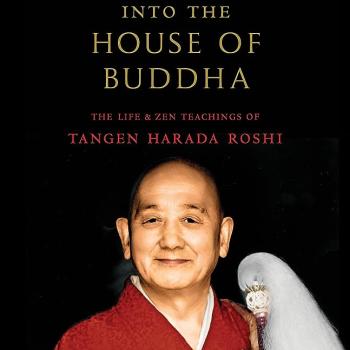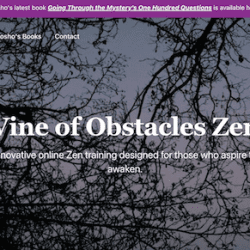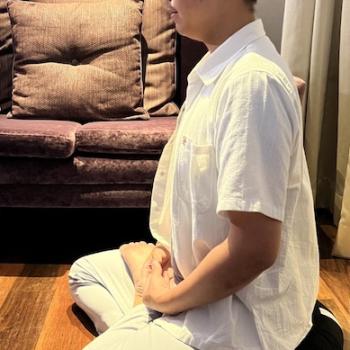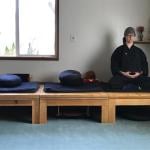When you reach this point of “no stink of enlightenment” where there is no trace, you vow with great determination to let the absence of enlightenment continue long, long, long like a single rail of iron for myriad miles. This is Great Practice that encompasses the entire future. – Bokusan
As the old saying goes, “Zen is like soap. First we wash with it and then we wash it off.”
In this post I’ll focus on the Great Practice aspect of Bokusan’s Genjokoan comments. I’ve written here before about the meaning of shu and gyo.
Dogen’s Daishugyo fascicle parses the Wild Fox Koan, examining one aspect of our secret practice – that if we really train and realize then we’ll be free from karma and suffering. Then we’ll be safe and good and beyond the reproaches of this life.
In the old Wild Fox story, a Zen master became a wild fox for 500 lives because he said that a person of Great Practice was free from karma.
It is helpful to look carefully in order to discover what is meant here by “Great Practice.” Dai-shu-gyo is composed of three characters. “Dai” is great – simple enough, but too big to know.
“Shu” is often translated as “practice” but literally means to “govern oneself, conduct oneself well.” If each person engaged in the Buddha Way is to govern oneself, then each practitioner is sovereign.
Some teachers in the Zen world train students by first treating them like children with the teacher as the parent, as if this were the medieval world with its feudal power arrangement. People in the post-modern world are not serfs (or 18-year-old Japanese guys) so this approach is out of tune with the spirit of “shu. It may invite students who are willing to pretend to be children but this is not a recipe, in my view, for face-to-face transmission.
Here’s a koan from the Book of Serenity, Case 97, featuring a dialogue between a worldly sovereign and a dharma sovereign – two voices within each practitioner engaging in intimate inquiry together.
The introduction to the koan asks this question: “When a worldly sovereign of the dharma sovereign meet, what should they discuss?”
Emperor Doko spoke to Koke saying, “I have the treasure of the Central Plain. However, no one can set a price on it.”
Koke said, “Your Majesty, please lend it to me so that I may see.”
The emperor pulled the straps of his hat with both hands. Koke said, “Who can dare to set a price on the emperor’s treasure!”
The commentary has this helpful instruction: “First get to know the sovereign; then we must know s/he is in the Central Plain; after that I want to ask you where your jewel is.”
Katagiri Roshi often said to us, “You must be master of the self.”
Getting to know the sovereign is a precondition of truly being the master of the self, governing oneself well withing the flux and flow of the 10,000 things.
The third character in Daishugyo, “gyo” is also often glossed as “practice” (e.g., Dogen’s “Gyo-ji” is often translated as “Continuous Practice”). “Gyo” is a radical that refers to “going” or “action.”
Here’s a passage about “gyo” from Peter D. Hershock’s Liberating Intimacy: Enlightenment and Social Virtuosity in Ch’an Buddhism:
Originally, hsing (Japanese, gyo) had the primary senses of walking or walkways and doing in the sense of working…. In a largely nonvehicular society, walking connects us, establishing and maintaining in the most concrete and daily fashion our ongoing interrelation. No path or thoroughfare proceeds from wilderness or desert to more of the same, but only from family to family, from village to village. Our roads and markets lining them are evidence of the diverse manners in which we are continually being led together, the unique ways in which we benefit and share with and in one another’s labor.
“Gyo,” in its original usage had to do with moving, doing and connecting – with intimacy. Together, “shu+gyo” = governing oneself well within the activity of connection. The question in the Wild Fox koan, then, goes like this: “Is a person engaged in sovereign, intimate and immeasurable connection free from karma?
Freedom from karma is the activity of grinding off the stink of enlightenment and the stink of stink. Take, for example, the experience I had while studying with Katagiri Roshi that I mentioned recently. As I saw myself more clearly, I could hardly stand how self-centered I was. Barry commented how that is the basis of compassion for others in all their wonderful stinkiness. Nicely put.
And then ego co-opts this compassionate self and reifies it as something enduring. And then we see agin how stinky we are and rediscover again the basis for a living compassion.
Intensive forms of training like sesshin, help us sit facing ourselves for days without escape, sometimes steeping in the stink of whatever rotting corpse of a self we’re carrying. The wonderful virtue of sesshin is that it is relatively easy to discover that letting go, although counter-intuitive, is really the only sane option.
Capping Phrase:
“Stumbling about in darkness, you keep bumping into yourself thinking it’s someone else” (from Daido Loori’s note 3 to “107: Yumen’s Two Types of Sickness” in The True Dharma Eye: Zen Master Dogen’s Three Hundred Koans).











